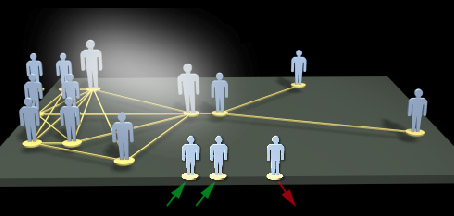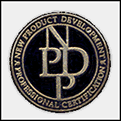Glossary for New Product Development
The following entries are from the perspective of an individual contributor to a new product development network. This glossary has been designed to provide insights to individuals such as engineers, scientists, programmers, marketers, and documentation specialists that are involved in new product development.
Other glossaries tend to reflect the perspectives of individuals such as those with Masters of Business Administration (MBAs) degrees, executives, and managers. Other glossaries tend to highlight the perspectives of the business or company.
Collaborate: Working together for the shared goal. In new product development (NPD), this objective is future success. Hopefully, cooperation produces synergy - a situation where the value of the new product is greater than the sum of the contributions of the individual developers.
Constrained: NPD activities are limited by a scarcity of resources such as time, money, or talent.
Developers: One of many possible terms that may refer to the contributors that intend to add value to the project. They provide individual expertise. Development networks usually include engineers, programmers, scientists, domain specialists, and technicians. In the preferred scenario, the network collaborates to produce significant value. The network strives to discover and deliver the product that will be desirable in the future.
Development: Noun
1. A result. Successful development is a significant consequence of activities that include the selection of an idea and its subsequent transformation to a much more valuable product.
2. The process of developing. Develop is to bring something to a more valuable state.
Efforts that contribute to successful development include enhancing the capabilities of individuals and networks so that they are more effective in transforming prototypes to more advanced or effective states. Development decisions are driven by questions about what to build for future success. In contrast, legacy sales and marketing efforts strive to sell more of what exists.
Typically, an individual’s role influences their perspective of new product development efforts. For example:
- Managers tend to accentuate the impact of processes. They track progress at each stage and make executive decisions.
- Individuals with business backgrounds tend to focus on financial metrics to forecast the future
- Individuals with a history in sales tend to anticipate new targets and quotas
- Marketers develop strategies and tactics for market launches
- Individual contributors such as engineers, coders, scientists, subject matter experts, and writers analyze the situation and synthesize options to create value within the project constraints. Some efforts tend to be individual and require discipline-specific proficiencies. Some efforts are collaborative.
NPD is non-deterministic. All of the new product 'requirements' can't be gathered from interviews before launch. There are unknowns throughout development. Experimentation occurs during development. Feedback from experiments produces insights that evolve development plans and deliverables.
Success is not guaranteed. A formula or template can be a guideline for success or a mistake. Adjustments to plans will be required. Most of the time, diligence, creativity, and experimentation are required.
Development Experience (DX): The set of perceptions and responses from a diverse set of individuals that develop a new product, system, or service. DX includes emotions, beliefs, preferences, perceptions, physical and psychological responses, behavior and accomplishments that occur before, during and after development. Factors that influence DX include the system, the individuals, and the context of development. DX varies over the time from concept to commercialization. (This definition is based on the ISO 9241-210 definition of User Experience, UX.)
Efforts related to DX are distinct from efforts that focus on the product or the intended user of the product. DX affects individuals that develop new products. UX affects individuals that use the product.
Development Experience Design: The design of the experiences of a diverse set of individual contributors during the development of new products. It includes factors related to the development environment such as those that impact cooperation, collaboration, cohesiveness, and harmony of anyone associated with the new product development network at any time during development. It addresses experiences related to the development of the hardware, software, interfaces, purchase, installation, setup, operation, and maintenance of the new product. It spans the time from concept to commercialization. Mark A Hart coined this phrase in 2013.
Development Experience Designer: An individual that strives to impact the perceptions and responses of a diverse set of contributors during the development of new products. A DX Designer strives to enhance the new product development capabilities of individual contributors. A DX Designer explores factors related to the development environment such as those that impact cooperation, collaboration, cohesiveness, and harmony of anyone associated with the new product development network at any time during development.
Individual Contributors: Individuals (such as designers, developers, scientists, engineers, coders, domain experts, and communication specialists) that transition in and out of new product development networks to contribute to both the Vision and Version for a new product to create a valuable experience for both the customer and themselves.
An individual contributor can improve their DX by shifting from their role of specialist to that a new product developer with certain specialties. This approach enables an individual contributor to elevate the value of what they create and minimize the cost of creating it.
Innovation Gap: The delay between the initial concept and launch. In addition, it may be the implementation delay between vision and version. The innovation gap may be partially due to assimilation delay (teaching time).
Launch: In general, launch means to set something in motion.
Launch can refer to the initial efforts related to new product development. Alternative phrases for this include ideation or front end of development.
Launch can refer to the validation portion of a new product development project. For an individual contributor, questions may include:
- Was a valuable solution developed?
- Were the assertions and other guesses (also known as forecasts, plans, and prioritized lists) true?
- What did I learn?
- Am I better prepared for the next project?
- Am I more valuable to other new product development efforts?
Launch may refer to the portion of development defined by the bookends of "initial sales of the product" and the "transition from the development team" to the "product delivery organization." By the time that departments such as marketing, sales, manufacturing, distribution, and shipping have integrated the "new" product with the legacy products, launch is complete. During launch, it is common for sales, support, and communication specialists to schedule events and activities designed to promote more sales but the preparation for such events may be distracting to some members of the development team.
Someone in a sales or marketing role may emphasize that launch is the process by which a new product is introduced into the market for initial sale. Typically, there is an emphasis on metrics such as revenue. This period is punctuated by various launch events that aligned with functional groups such as Sales, Marketing, or Support. This subset of launch may be categorized as the Market Launch.
Launch Architecture: A framework to enhance the capabilities of individuals in new product development. It provides focus and direction to product development efforts. With the appropriate actionable guidance, good plans get better, and individuals effectively contribute to system goals. The appropriate launch architecture ensures a better, faster, and more efficient path to launch success because it is a “launch objectives drive development” method.
New: Most often, a product change is needed because either the current products are not sufficient or the perception is that the current products will be unacceptable soon.
New Product Development (NPD): Overall, NPD is a constrained discovery process in search of success in the future. Typically NPD begins with a notion that evolves to a concept (that can be summarized in a page or two) and transitions to development that includes launch and commercialization. Since there are so many possible permutations (such as the choice of individual contributors, strategies, tactics, decisions, plans, and objectives) during development, one's approach is a critical success factor.
New Product Development (NPD) Network: a temporary, dynamic, adaptive system designed to evolve a product vision and compare that to the reality of their current version. In an NPD network, individuals may report to multiple managers in multiple companies and have multiple priorities. Many individuals engage and disengage during the project.
Functionally, an NPD network is more like a neural network than a computer network. The structure of an NPD network changes throughout development.
Often, the word "teams" implies that most of the individual contributors are employed by one organization and assigned to a relatively small number of functional areas (such as engineering and marketing). Often, an individual is assigned to a project for most of the duration of the project. In contrast, NPD work groups are assigned specific tasks.
Optimization: The rigorous, context-sensitive selection of better development alternatives to maximize the potential for launch success. It includes engaging the appropriate developers, encouraging collaboration, and improving resiliency.
Obliquity, Principle of: For better results, some goals should be achieved indirectly. For example: To develop better new products, invest to enhance the NPD capabilities of the individual contributors.
Engaging the appropriate individual contributors and enlisting the appropriate leadership maximizes the probability of The product's success.
Optimizing: a deliberate effort to improve continually.
Optionality: a quality of state where choice or discretion is allowed.
In a new product development environment, properly prepared individuals benefit more by exercising options than by managing mandates. In a properly designed new product development environment, proficient individuals continuously synthesize new options. The interplay of synthesizing options and exercising options has the potential to provide multiple benefits.
Pair Development is implemented by facilitating the interaction of individuals of different disciplines (such as a coder and a marketer). Pair development provides an opportunity for interaction through, for example, dialog and sketching. The result of pair development should be the synthesis of options, not a summary of previous activities.
The purpose of pair development is not cross-training. The purpose is to develop a self-correcting focus and direction informed by the analyses of multiple perspectives.
Success: Common product validation proxies relates to characterizations such as "abundant sales" or a high percentage of five-star customer reviews. Project success may be evaluated by other proxies such as positive Development Experience ratings.
Synergy (also synergism): a combined, mutually advantageous interaction that produces a combined effect greater than the sum of the efforts of separate individuals.
Synergist: A new product development synergist helps individuals (such as engineers, programmers, designers, marketers,...) become more valuable contributors within networks that develop new products. A synergist enhances the effectiveness of others actively engaged in development.
Vision: The imagined, future state of the evolving description of a product. The vision is the result of input from many perspectives (such as product management, sales, marketing, engineering, quality assurance, distribution, and customers). It is embodied in the documentation that typically includes text, images, and various types of forecasts. See also: Version.

Version: Any of the physical product prototypes or other items such as working software or other proof of concept items that can be used to demonstrate the embodiment of some aspect of the Vision.
X-up: A temporary condition when one or more contributors is capable of enhanced behavior. In new product development, an X-up state may be characterized as a period of beneficial behavior such as extraordinary cooperation, collaboration, effectiveness, efficiency, or harmony. During a X-up event, an individual contributor increases the value of what they create and minimize the cost of creating it.
X-up is a reference to a state in games such as Nintendo's Super Mario Brothers where Mario interacts with special objects (such as a super mushroom or fire flower) that instantly benefit or add extra abilities to the game character ass a game mechanic. In the game, an example of a power-up condition is invincibility. Also known as Power-up.

